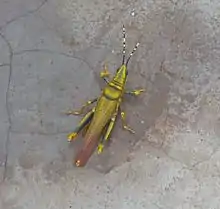Poekilocerus pictus
Poekilocerus pictus is a large brightly coloured grasshopper found in the Indian subcontinent.[1] Nymphs of the species are notorious for squirting a jet of liquid up to several inches away when grasped.[2] It is also known as Aak grasshopper [3] or locally in few tribal areas called titighodo.[4]
| Painted Grasshopper | |
|---|---|
 | |
| Scientific classification | |
| Kingdom: | Animalia |
| Phylum: | Arthropoda |
| Class: | Insecta |
| Order: | Orthoptera |
| Suborder: | Caelifera |
| Family: | Pyrgomorphidae |
| Subfamily: | Pyrgomorphinae |
| Genus: | Poekilocerus |
| Species: | P. pictus |
| Binomial name | |
| Poekilocerus pictus (Fabricius, 1775) | |
Description

The half-grown immature form is greenish-yellow with fine black markings and small crimson spots. The mature grasshopper has canary yellow and turquoise stripes on its body, green tegmina with yellow spots, and pale red hind wings.[2]
It changes its outward appearance by molting.
Habits
The grasshopper feeds on the poisonous plant Calotropis gigantea.[2]
Upon slight pinching of the head or abdomen, the half-grown immature form ejects liquid in a sharp and sudden jet, with a range of two inches or more, from a dorsal opening between the first and second abdominal segments. The discharge is directed towards the pinched area and may be repeated several times. The liquid is pale and milky, slightly viscous and bad-tasting,[2] containing cardiac glycosides that the insect obtains from the plant it feeds upon.[5][6]
In the adult, the discharge occurs under the tegmina and collects as viscous bubbly heap along the sides of the body.[2]
See also
- Bombardier beetle, notable family of squirting beetles.
 Painted Grasshopper & its Molt
Painted Grasshopper & its Molt  Painted Grasshopper at Yeoor
Painted Grasshopper at Yeoor
References
- Orthoptera Species File (retrieved 7 April 2018)
- Hingston, M. R. W. G. (2009). "The Liquid-Squirting Habit of Oriental Grasshoppers". Transactions of the Royal Entomological Society of London. 75: 65. doi:10.1111/j.1365-2311.1927.tb00060.x.
- Sawant, Madhavi (May–Aug 2010). "STUDY OF JUVENILE AND ADULT GROWTH, AND BEHAVIOURAL CHARACTERISTICS OF POECILOCERUS PICTUS (FABRICIUS) FEEDING ON CALOTROPIS GIGANTEA UNDER LABORATORY CONDITIONS". Journal of the Bombay Natural History Society. 107 (2): 122–129. Archived from the original on 27 July 2014. Retrieved 25 July 2014.
- Shrivastava, SK (Oct 2009). "Traditional insect bioprospecting – As human food and medicine". Indian Journal of Traditional Knowledge. 8: 485–494. Retrieved 25 July 2014.
- Mathen, C; Hardikar, B (2010). "Cytotoxic compounds from Poecilocerus pictus feeding on Calotropis gigantea". Journal of experimental therapeutics & oncology. 8 (3): 177–85. PMID 20734917.
- Wang, Z. N.; Wang, M. Y.; Mei, W. L.; Han, Z.; Dai, H. F. (2008). "A New Cytotoxic Pregnanone from Calotropis gigantea". Molecules. 13 (12): 3033–9. CiteSeerX 10.1.1.361.9898. doi:10.3390/molecules13123033. PMID 19052526.


